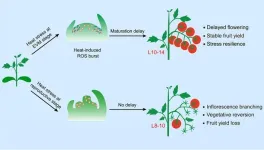(Press-News.org) Bottom Line: Precancerous pancreatic lesions and some pancreatic ductal adenocarcinoma (PDAC) tumors harboring KRAS mutations had higher-than-normal expression of the FGFR2 protein, and FGFR2 inactivation delayed KRAS-mutated PDAC development in mice.
Journal in Which the Study was Published: Cancer Research, a journal of the American Association for Cancer Research
Author: Claudia Tonelli, PhD, a research investigator in the laboratory of AACR Past President David A. Tuveson, MD, PhD, FAACR, at Cold Spring Harbor Laboratory
Background: PDAC is the most common type of pancreatic cancer, a highly lethal malignancy that is often preceded by precancerous lesions. These lesions are relatively common, but only a small portion will progress to PDAC, Tonelli explained.
While mutations in the KRAS protein are known to drive pancreatic cancer, these do not appear to be sufficient to promote the transition from precancerous lesions to cancer, Tonelli noted. “Understanding the additional pathways that promote progression from a precancerous pancreatic lesion to a malignant tumor could help identify more viable treatment strategies as well as cancer interception approaches to stop PDAC from developing in the first place,” she added.
How the Study was Conducted: By analyzing murine and human pancreatic tissue specimens, Tonelli and colleagues found that, compared with normal tissue, FGFR2 expression was higher in KRAS-mutated precancerous lesions and some KRAS-mutated PDAC. Notably, FGFR2 expression in murine precancerous lesions correlated with an increase in mutant KRAS signaling.
“We know that precancerous pancreatic lesions often carry KRAS mutations,” said Tonelli. “Our observation that FGFR2 expression was associated with increased KRAS signaling suggests that FGFR2 may play a key role in driving the progression of KRAS-mutated precancerous lesions to malignancy.”
Results: Consistent with this hypothesis, the researchers found significantly fewer precancerous lesions and delayed PDAC tumors formation in KRAS-mutated mice in which the FGFR2 gene had been deleted compared with those with an intact FGFR2 gene. In addition, the combined inhibition of FGFR2 and another signaling protein, EGFR, significantly reduced the formation of precancerous lesions in mice carrying mutated KRAS.
Author’s Comments: According to Tonelli, the findings suggest that targeting FGFR2 could potentially benefit patients at high risk of their precancerous lesions progressing to PDAC. While FGFR inhibitors are clinically available, Tonelli cautioned that their effectiveness in intercepting PDAC would first need to be tested in clinical trials before they could be used for this purpose.
“Our study provides critical insights into pancreatic cancer development and could guide the development of strategies for the interception and prevention of pancreatic malignancies,” she summarized.
Study Limitations: A limitation of the study is that it did not directly examine whether FGFR2 inactivation in precancerous lesions would also block or delay subsequent PDAC. This could be addressed in future studies by performing long-term FGFR2 inhibition, or alternatively by genetic experiments, Tonelli noted.
Funding & Disclosures: The study was supported by the National Institutes of Health and the Lustgarten Foundation. Tonelli reports no potential conflicts of interest.
END
Targeting FGFR2 may prevent or delay some KRAS-mutated pancreatic cancers
The preclinical study has implications for pancreatic cancer interception efforts
2025-04-02
ELSE PRESS RELEASES FROM THIS DATE:
Melodies of musical ‘starquakes’ shed new light on how our galaxy formed
2025-04-02
They say music is the universal language of humankind, but some stars in our galaxy exhibit their own rhythm, offering fresh clues into how they and our galaxy evolved over time.
According to an international team of researchers, including scientists from The Australian National University (ANU) and UNSW Sydney, some stars exhibit fluctuations in their brightness over time, which are caused by continuous ‘starquakes’.
These fluctuations can be translated into frequencies, which can be used to determine a star’s age and other properties ...
Protective radar for bacteria
2025-04-02
Investigation how microorganisms communicate enhances our understanding of the complex ecological interactions that shape our environment – a major focus of the Cluster of Excellence “Balance of the Microverse”. A research team of the Cluster at the Leibniz Institute for Natural Product Research and Infection Biology - Hans Knöll Institute (Leibniz-HKI) and the Friedrich Schiller University, Jena has studied the interaction between amoebae, bacteria, and plants. Researchers from the ...
Increased utilization of overtime and agency nurses and patient safety
2025-04-02
About The Study: The findings of this study suggest that both nurse overtime and nurse agency hours are associated with increased rates of pressure ulcers, a measure that is one of the most sensitive to nursing care. In future research, hospitals could use their own data to track safe thresholds.
Corresponding Author: To contact the corresponding author, Patricia Pittman, PhD, email ppittman@gwu.edu.
To access the embargoed study: Visit our For The Media website at this link https://media.jamanetwork.com/
(doi:10.1001/jamanetworkopen.2025.2875)
Editor’s ...
Spending on glucagon-like peptide-1 receptor agonists among US adults
2025-04-02
About The Study: Spending on glucagon-like peptide-1 receptor agonists (GLP-1 RAs) increased from 2018 to 2023, with the largest growth rates from 2022 to 2023. Although spending for certain GLP-1 RAs increased substantially, spending declined for others. This study estimated that more than $71 billion was spent on GLP-1 RAs and more than $50 billion on a product based on either semaglutide or tirzepatide molecules.
Corresponding Author: To contact the corresponding author, Stavros Tsipas, MA, email stavros.tsipas@ama-assn.org.
To ...
Early-life ozone exposure and asthma and wheeze in children
2025-04-02
About The Study: In this cohort study with relatively low ambient ozone exposure, early-life ozone was associated with asthma and wheeze outcomes at age 4 to 6 and in mixture with other air pollutants but not at age 8 to 9. Regulating and reducing exposure to ambient ozone may help reduce the significant public health burden of asthma among U.S. children.
Corresponding Author: To contact the corresponding author, Logan C. Dearborn, MPH, email dearbl@uw.edu.
To access the embargoed study: Visit our For The Media website at this link https://media.jamanetwork.com/
(doi:10.1001/jamanetworkopen.2025.4121)
Editor’s ...
Early Earth's first crust composition discovery rewrites geological timeline
2025-04-02
Researchers have made a new discovery that changes our understanding of Earth’s early geological history, challenging beliefs about how our continents formed and when plate tectonics began.
A study published in Nature on 2 April reveals that Earth's first crust, formed about 4.5 billion years ago, probably had chemical features remarkably like today’s continental crust.
This suggests the distinctive chemical signature of our continents was established at the very beginning of Earth’s history.
Professor Emeritus Simon ...
Dark diversity reveals global impoverishment of natural vegetation
2025-04-02
A study recently published in Nature indicates that human activities have a negative effect on the biodiversity of wildlife hundreds of kilometres away. A research collaboration led by the University of Tartu assessed the health of ecosystems worldwide, considering both the number of plant species found and the dark diversity – the missing ecologically suitable species.
For the study, over 200 researchers studied plants at nearly 5,500 sites in 119 regions worldwide, including all continents. At each site, they recorded all plant species on 100 m2 and identified the dark diversity – native species that could live there but were absent. ...
Study finds rates of breast and colorectal cancer screening nearly four-fold higher than lung cancer screening among those eligible
2025-04-02
Lung cancer screening has the potential to catch lung cancer early and save lives—but only if people get screened. Although lung cancer screening is recommended in the U.S. for certain individuals with a history of smoking, only 18% of eligible individuals in the U.S. get screened. One suggested explanation has been that those eligible are resistant to receiving preventive healthcare, but a new study published in JAMA and led by researchers at Mass General Brigham indicates otherwise.
Researchers from Mass General Brigham sought to investigate use of other preventive healthcare services among individuals eligible for lung cancer screening. ...
Sound frequencies of stars sing of our galaxy’s past and future
2025-04-02
A new study led by UNSW Sydney researchers into a cluster of stars 2700 light years away reveals their stages of evolution through the ‘sounds’ they make. This discovery will allow scientists to map the history of the Milky Way and other galaxies, accelerating knowledge in the field of astrophysics.
Dr Claudia Reyes is the lead author of the study published today in Nature. While undertaking her PhD at the UNSW School of Physics, she studied 27 stars in a cluster of stars called M67. The stars in ...
Tomato plants delay shoot meristem maturation to achieve heat-stress resilience
2025-04-02
As global temperatures continue to rise, extreme heatwaves pose a significant threat to agricultural productivity. Studies estimate that for every 1°C increase above pre-industrial levels, crop yields decline by approximately 6-8%. The ability of plants to withstand heat stress is therefore critical for ensuring food security, yet the underlying molecular mechanisms have largely remained elusive.
Now, however, a new study led by Prof. XU Cao's team at the Institute of Genetics and Developmental Biology (IGDB) of the Chinese Academy of Sciences sheds light on an adaptive strategy that may ...
LAST 30 PRESS RELEASES:
Scalable and healable gradient textiles for multi‑scenario radiative cooling via bicomponent blow spinning
Research shows informed traders never let a good climate crisis go to waste
Intelligent XGBoost framework enhances asphalt pavement skid resistance assessment
Dual-function biomaterials for postoperative osteosarcoma: Tumor suppression and bone regeneration
New framework reveals where transport emissions concentrate in Singapore
NTP-enhanced lattice oxygen activation in Ce-Co catalysts for low-temperature soot combustion
Synergistic interface engineering in Cu-Zn-Ce catalysts for efficient CO2 hydrogenation to methanol
COVID-19 leaves a lasting mark on the human brain
Scientists use ultrasound to soften and treat cancer tumors without damaging healthy tissue
Community swimming program for Black youth boosts skills, sense of belonging, study finds
Specific depressive symptoms in midlife linked to increased dementia risk
An ‘illuminating’ design sheds light on cholesterol
Who is more likely to get long COVID?
Study showcases resilience and rapid growth of “living rocks”
Naval Research Lab diver earns Office of Naval Research 2025 Sailor of the Year
New Mayo-led study establishes practical definition for rapidly progressive dementia
Fossil fuel industry’s “climate false solutions” reinforce its power and aggravate environmental injustice
Researchers reveal bias in a widely used measure of algorithm performance
Alcohol causes cancer. A study from IOCB Prague confirms damage to DNA and shows how cells defend against it
Hidden viruses in wastewater treatment may shape public health risks, study finds
Unlock the power of nature: how biomass can transform climate mitigation
Biochar reshapes hidden soil microbes that capture carbon dioxide in farmland
Reducing saturated fat intake shows mortality benefit, but only in high-risk individuals
Manta rays create mobile ecosystems, study finds
Study: Mixed results in using lipoic acid to treat progressive multiple sclerosis
Norbert Holtkamp appointed director of Fermi National Accelerator Laboratory
New agentic AI platform accelerates advanced optics design
Biologists discover neurons use physical signals — not electricity — to stabilize communication
Researchers discover that a hormone can access the brain by hitchhiking
University of Oklahoma researcher awarded funding to pursue AI-powered material design
[Press-News.org] Targeting FGFR2 may prevent or delay some KRAS-mutated pancreatic cancersThe preclinical study has implications for pancreatic cancer interception efforts



